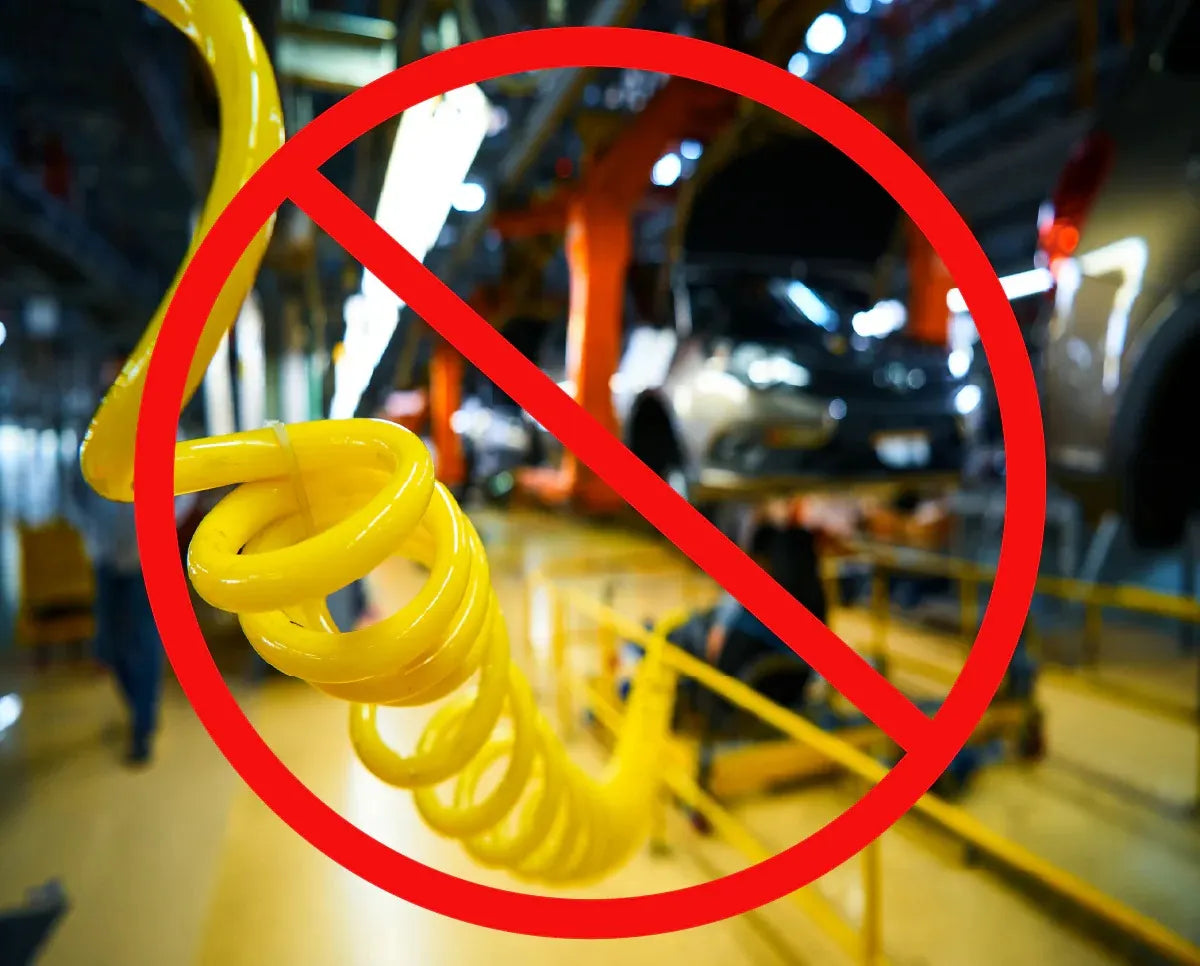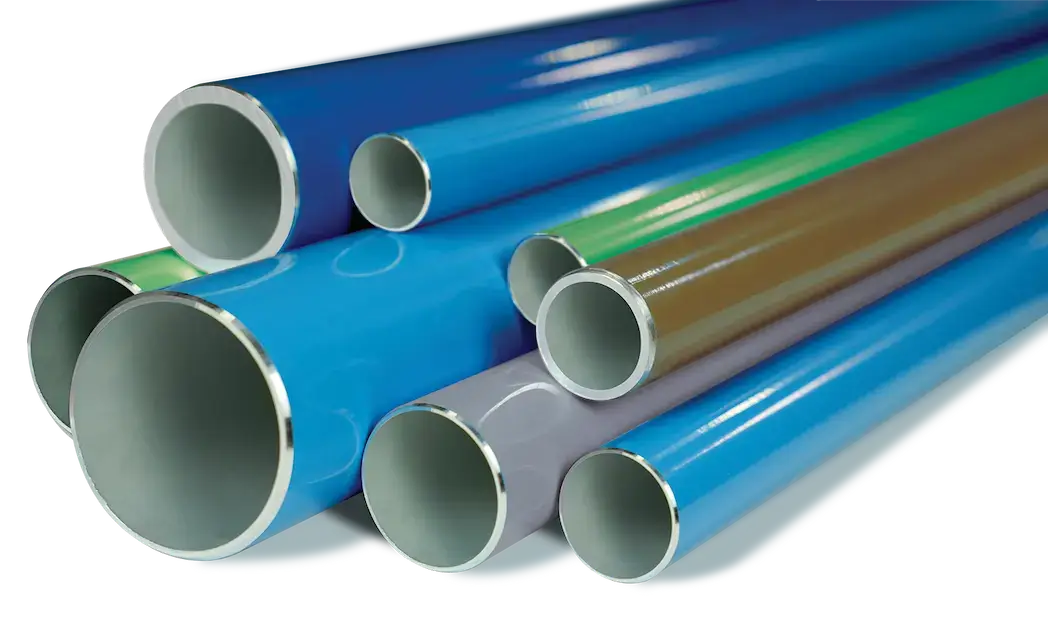When it comes to compressed air distribution, flexible hoses are often seen as a quick fix. But relying on them for long-term use is not considered best practice.
A typical air hose may provide short-term flexibility, but it introduces risks like leaks, pressure drops, safety hazards and early failure. These risks compromise efficiency and drive up operating costs. In demanding industrial environments, these weaknesses add up to wasted energy and costly downtime.
The better solution is a durable, purpose-built compressed air piping system that delivers both flexibility and reliability.
That’s where Unipipe comes in.
As a leader in modular aluminum piping systems, Unipipe provides secure, long-lasting alternatives to hoses for compressed air distribution. With Unipipe, facilities gain the confidence of a leak-free distribution system that meets compressed air best practices and avoids common problems that may arise with flexible hoses.
Common Problems with Flexible Hoses in Compressed Air Systems
A flexible hose for compressed air may seem convenient, but in daily operation, it quickly reveals problems that go against compressed air best practices. Operators often deal with these issues firsthand:
-
Frequent leaks: Hose joints and connections gradually lose their sealing ability, while the air hoses themselves can develop microcracks and pinhole leaks. Even a small leak adds up to wasted energy, forcing the compressor to run longer and increasing utility costs.
-
Pressure drops: Kinks and bends restrict airflow, while leaks result in pressure drop from air loss. This results in inconsistent pressure at the point of use, which can slow down tools and reduce productivity.
-
Short lifespan: Rubber or PVC materials wear out quickly under constant pressure, vibration and temperature changes. This leads to frequent replacement, creating added maintenance costs and downtime.
-
Safety hazards: Flexible hoses are not designed for long-term exposure to compressed air pressures. A sudden rupture can create whipping hoses, flying debris and serious injury risks.
These symptoms are not just inconveniences; they directly conflict with industry best practices for energy efficiency, reliability and workplace safety. Every leak, crack or pressure drop contributes to higher operating costs and greater risk. For facilities looking to optimize performance, replacing flexible hoses with a durable compressed air piping system is a safer, more efficient choice.

Energy and Cost Impact of Flexible Hoses
Flexible hoses don’t just cause performance issues; they quietly drain energy and money from your operation. What seems like a low-cost fix often turns into a long-term expense.
Leaks and Pressure Drops Increase Energy Demand
Rubber and flexible hoses are notorious for developing leaks, cracks and kinks. Even small air losses force compressors to cycle more frequently and run harder to maintain system pressure. The result: wasted energy and higher wear on critical equipment.
Higher Operating Pressure Means Higher Bills
To compensate for hose-related inefficiencies, many facilities increase discharge pressure at the compressor. But this strategy is costly. Every 2 PSI increase in pressure raises energy consumption by about 1%, meaning a 20 PSI loss through hoses or restrictions can waste roughly 10% of your energy costs. Raising plant pressure to compensate inflates utility bills without solving the root problem.
The Hidden Costs of Flexible Hoses
Energy waste is only part of the equation. Hoses also fail more frequently than purpose-built piping, resulting in recurring repair costs, downtime for replacements and unnecessary safety risks. Over time, these hidden costs far outweigh any initial savings.
By replacing flexible hoses with a reliable compressed air system, facilities can lower energy demand, reduce maintenance and gain consistent performance that supports true compressed air best practices.
Compressed Air Connections: What to Use Instead of Flexible Hoses
While an air hose may feel like a quick solution, it’s not designed for long-term reliability in compressed air systems. Best practice is to build your network with rigid, purpose-built materials.
Modular aluminum compressed air piping has become the industry standard for its strength, efficiency and ease of installation. Aluminum pipe maintains consistent pressure and flow across your facility, reducing leaks and eliminating energy losses.

When specific connections are required, Unipipe offers components that make installation and expansion simple. Threaded connectors provide a secure way to link different parts of the system, while fitting O-rings and grip rings deliver tight, leak-free seals. These components ensure your compressed air piping performs reliably, even in high-demand environments.

The benefits are clear:
- Lower energy costs from eliminating leaks and pressure drops.
- Reliable performance with steady airflow and clean distribution.
- Long lifespan thanks to corrosion-resistant aluminum and durable fittings.
By replacing hoses with modular piping and engineered connectors, you get a system that meets best practices in compressed air distribution, which delivers efficiency, safety and long-term savings.
Aluminum Piping: The Best Alternative to Flexible Hoses
Flexible hoses might seem like a quick and inexpensive fix, but in compressed air systems, they create more problems than they solve-like leaks, pressure drops, higher energy costs and safety risks.
The truth is, short-term savings often lead to long-term expenses. Following compressed air best practices means choosing durable piping and reliable connectors that protect efficiency and safety. A modular aluminum piping system delivers consistent performance, long lifespan and lower total cost of ownership.
As a trusted provider of complete compressed air systems, Unipipe provides durable, leak-free distribution piping for compressed air, nitrogen and inert gas, vacuum systems and more. Invest in quality today and ensure your operation runs smoothly, efficiently and safely.
FAQ
What material is best for permanent compressed air piping?
How much energy could I save by replacing flexible hoses?
What’s the lifespan of a rigid system compared to hoses?
Does upgrading mean shutting down the whole system?
Can Unipipe solutions handle facility expansion in the future?
Need Help Choosing the Right Compressed Air Piping Solution?
Still relying on flexible hoses? Unipipe can help you transition to durable, energy-efficient piping that meets compressed air best practices. From air hose alternatives to complete leak-free system design, our team will ensure your setup is safe, reliable and built to last.
Choose Unipipe for reliable, long-lasting results. Contact us today to purchase or become a Unipipe reseller.





